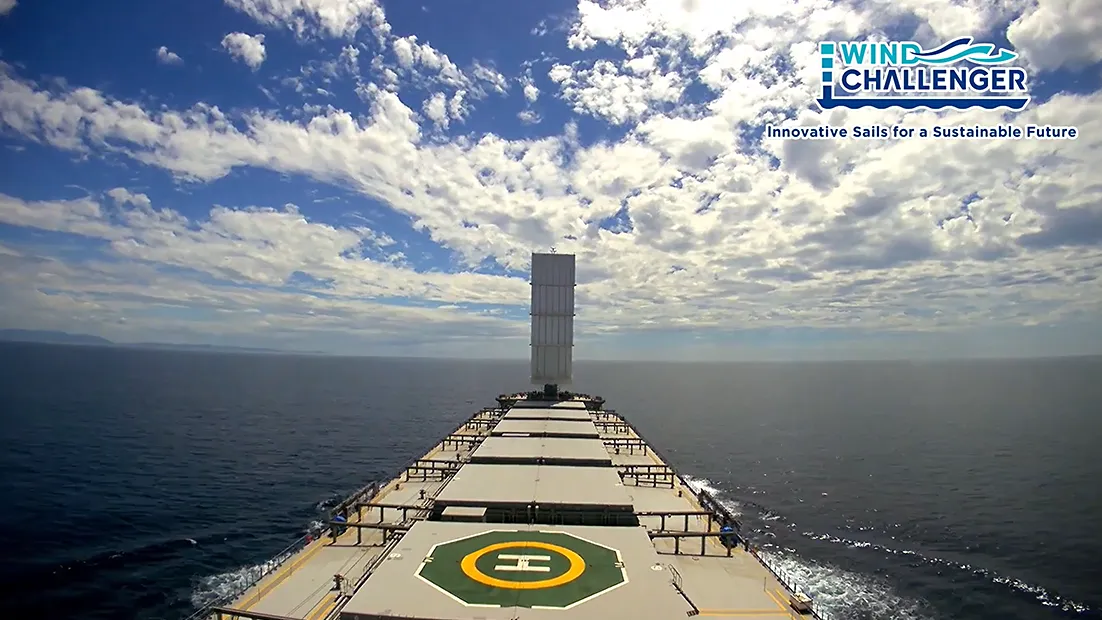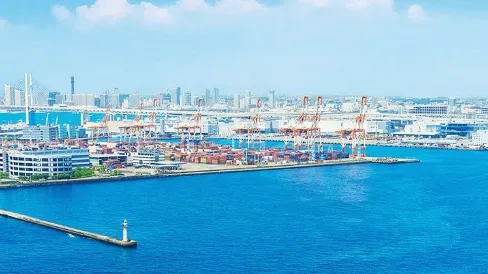
ENERGY SAVING TECHNOLOGY / SMART NAVGATION
MOL is working to improve operational efficiency and reduce CO2 emissions by adopting wind power as the vessel's propulsive force and various types of energy-saving equipment. To further improve both efficiency and safety, the company is promoting maritime digital transformation (DX) through the “FOCUS” initiative and investing in maritime skills education and training.
Efforts to reduce GHG emissions that we can begin utilizing immediately -Adoption of energy-saving technology and smart navigation-
Compared to other methods, shipping can transport large quantities of goods at once, and the emissions per unit transport of CO2 are clearly reduced. Basically, However, due to the global economic growth spurred by the development of emerging countries, the volume of marine cargo continues to increase on a global scale. Currently, more than 10 billion tons of ocean transportation per year are expected to increase.
The more active cargo movements at sea, related to the increase of both energy consumption and the more CO2 emissions, deepening environmental problems such as global warming.
The CO2 emitted by oceangoing vessels is estimated to be about 2% of global emissions.
MOL is working to reduce CO2 emissions from ships by introducing eco-friendly ship models that reduce wind pressure resistance as much as possible, optimizing operating routes, reducing speed, introducing clean alternative fuel, and training to develop high-quality maritime technicians. We are supporting environmental measures that can be introduced immediately.
MOL Group’s Pathway to Net Zero GHG Emissions

Service Lineup
WIND CHALLENGER
Mitsui O.S.K. Lines, Ltd. (MOL) has developed the Wind Challenger, which converts wind energy directly to a vessel propulsion force through an extensive use of the latest technologies. Wind energy is clean and unlimited. We aim to drastically reduce greenhouse gas emissions by converting wind energy to propulsion force for ships. In October 2022, the 1st vessel, “SHOFU MARU” was delivered and started operation.
We have decided to build the 2nd vessel and it is planned to deliver in 2024.

PBCF (Propeller Boss Cap Fins)
PBCF is the energy-saving device focusing on recovering energy lost due to the propeller hub vortex.
It breaks up the hub vortex generated behind the rotating propeller, reducing the ship’s fuel consumption and in turn cutting CO2 emissions. Regardless of vessel type and size, it demonstrates a reliable energy saving effect of about 5% and easy installation.

FOCUS
MOL has developed FOCUS (Fleet Optimal Control Unified System), an advanced support technologies, to utilize digital technology to achieve safer, more efficient, and more environmentally friendly ship operation.
This system will promote digital transformation in the shipping industry and contribute to the development of the industry by continuing to provide value to a wide range of stakeholders.

Maritime Education & Training
Our training programs have been designed based on our experiences spanning over 130 years. These programs are now offered to the wider industry to prevent accidents and to promote further growth of maritime transportation.

Simulators
MOL offers practical maritime education and consulting services using a wide range of simulators, supported by certified facilities and experienced maritime professionals. In addition, MOL Maritex, a DNV-certified company, provides maritime education and training for MOL.

Related Case Studies
-

WIND CHALLENGER Sea Trial
Wind ChallengerMitsui O.S.K. Lines, Ltd. (MOL) has developed the Wind Challenger, which converts wind energy directly to a vessel propulsion force. As a part of this project, the hard sail system to be installed on the first Wind Challenger ship was finally completed in February 2022.
-

WIND CHALLENGER Delivered the First vessel
Wind ChallengerMitsui O.S.K. Lines, Ltd. (MOL) has developed the Wind Challenger, which converts wind energy directly to a vessel propulsion force. As a part of this project, the hard sail system to be installed on the first Wind Challenger ship was finally completed in February 2022.
-

WIND CHALLENGER Hard Sail Completed
Wind ChallengerThe hard sail system to be installed on the first Wind Challenger ship was finally completed.
-

DELIVERY OF 1ST WIND CHALLENGER
Wind ChallengerAs part of our greenhouse gas (GHG) emission reduction project, the first Wind Challenger is scheduled for completion.
-

COAST GUARD ENGINEER TRAINING
TrainingWe provided training to Engineers from the Philippine Coast Guard to help them understand methods of operating main engines and generators and to improve their repair skills.
-

INTERNSHIP TUMST X MMMA
TrainingStudents from MMMA and the Tokyo University of Marine Science and Technology interact through internship programs.
Other Service Categories
-

ADOPT CLEAN ENERGY
Mitsui O.S.K. Lines, Ltd. aims to achieve zero GHG Emissions from vessels by 2050. Learn about some of the projects we are working on to introduce clean energy.
-

LOW-CARBON / DECARBONIZED BUSINESS
Mitsui O.S.K. Lines, Ltd. is actively promoting initiatives for negative emissions, from manufacturing to transportation and supply, across the value chain, as part of its efforts to create a framework for achieving net zero GHG emissions. Learn about the low-carbon and decarbonization projects that we are working on.
-

COMPREHENSIVE TRANSPORT
MOL Project & Heavy Cargo is a unified brand of MOL, providing heavy and oversized cargo transportation. The Mitsui O.S.K. Lines Group offers a door-to-door service covering every aspect, from marine, land, and air transportation to installation, under this brand.
We offer comprehensive transportation services leveraging the global network of the MOL Group.
Contact
- Top
- ENERGY SAVING TECHNOLOGY / SMART NAVGATION



